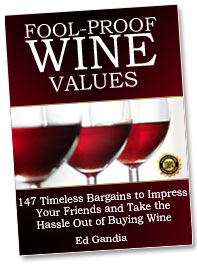Learn About Sparkling Wine Production
Learn About Sparkling Wine Production
It still makes me chuckle when I overhear certain types of people talk about wine. People who obviously know nothing about it, but who have read an article in Wine Spectator and have suddenly become experts on a subject. Let me explain. As a wine expert myself, (stop laughing) I hold a lot of wine tastings for different venues in my area and it always happens that there are a few beginner wine drinkers who show up, led by their new-to-wine friends who are always eager to share some new-found wine knowledge. Why they wait to share it at a public wine tasting I don’t know, but I suppose it’s to make themselves look good in front of their even greener wine-newb friends. As I said, for me, it just makes me laugh. No offense to the newb reading this if you saw me last weekend.
So at this particular event I overhear a guy talking about wine production. He’s telling his lady friend all about the clarification process of winemaking, malo-lactic treatment, and it’s impressing me because for the most part he’s got it right. I was almost starting to think he’d been reading my Learn About Wine blog (stop laughing). Then I pick up on that he’s talking about sparkling wine, but he’s calling it Champagne. He likes Italian Champagne because it tends to be a little sweeter; South African Champagne does nothing for him, have you ever tried a pink Champagne from France? (Okay, so he had that one, until he mentioned Loire Valley)… Now, I don’t mean to pick on the guy or any of you who don’t get it; it just makes me giggle is all. And maybe his petty ignorance of the subject is a little bit of the wine snob coming out in me, so for my own appeasement let me set the record straight. Sparkling wine can only be classified as Champagne if in fact it comes from the Champagne region of France. EVERYTHING else is considered sparkling wine. It will have a different name for sparkling depending on its region of origin, for instance Italian sparkling is called Spumante, Spanish sparkling is Cava, in California it’s called sparkling wine, etc..; but they are all still classified as sparkling wines.
So, that little anecdote led me to this post about sparkling wine production. I’ve talked about sparkling wine in a previous post, but this time I want to go over some of the finer points being that Valentine’s Day is right around the corner. And yes, chocolate is a perfect compliment for sparkling wine at Valentine’s Day. Think chocolate and strawberries.
So let’s get this started as it will most likely be a very long post.
Sparkling Wine Production
What it boils down to is in sparkling wine production the process is the same as white wine production and red wine production but sparkling wine production adds a few more steps.
I think I mentioned before that sparkling wine production was first put into practice by Benedicitine monks of St. Hilaire in Limoux, France around the late seventeenth century, the most famous among them being Dom Pérignon. You may have heard of him. The monks stumbled upon the process actually.
As the wine was left to ferment over winter, the juice would go into a sort of “suspended animation” as it chilled, trapping the CO2 in the wine. Once it was warm again and the must thawed the yeast would be reactivated and would continue the fermentation process. The amount of bubbles in the wine depended on how far along fermentation had gone before freezing. Pérignon took this natural occurrence and perfected it into the sparkling wine production we know of today. Fortunately for our wallets others took on the practice of sparkling wine production and today we can all enjoy sparkling wine, Champagne or otherwise.
I’ve put together a list of grapes involved in sparkling wine production across the globe. And there are actually quite a few that are suitable for sparkling wine. More than you would think. Let’s take a look.
- Champagne France: Pinot Noir, Pinot Meunier, Chardonnay
- United States: Pinot Noir, Pinot Meunier, Chardonnay, Pinot Blanc
- Loire Valley, France: Chenin Blanc
- Germany: Riesling, Elbing, Gewürztraminer
- Italy: Muscat, Brachetto, Prosecco/li>
- Spain: Xarel-lo, Macabeo, Parellada
- Australia: Shiraz
All sparklings, no matter the grape used require high acidity and low sugar levels to produce a great sparkling product.
The benefit of low sugar levels is that it produces a low alcohol level base wine which is important in the first fermentation. If the alcohol level is too high it will kill the yeast before the second fermentation can even get started. Because of this, the grapes used in sparkling wine production are harvested before they are ripe. Acids haven’t had time to dip and sugar levels as well as pigment levels haven’t had time to develop.
When considering skin pigments of red grapes winemakers tend to harvest the fruit while it is still cold so that the pigment doesn’t tint the juice during pressing or tints it just enough as in the case with sparkling Rosé. Most sparkling wines are cluster-pressed, that means they throw bunches of grapes still attached to their stems (think of like you see in the grocery stores) in the press, but there are a few sparkling red wines that utilize crushing. These sparkling red wines are actually red.
The Champagne Press
A traditional champagne press looks like a wide, flat oak barrel that’s been cut in half along its diameter. It’s not as widely used today as the bladder press but it hasn’t outlived its function yet. After the grapes are pressed for the first time the top of the champagne press (called the mouton) is opened and the grapes are shoveled toward the center of the press with wooden shovels (pelles). This entire process is called “retroussage” [ruh-troo-sahzh]. The must goes through retroussage several times before it is over.
While the grapes are being pressed, juice from the grapes is pulled in stages called tailles [ties], meaning “cut”. The various cuts are Cuvée, Première taille, Deuxième [Duhz-yee-Em]
taille and Rebèche [ruh-Besh].
You might’ve seen Cuvée on a Champagne bottle at one time. Cuvée means first pressing. And that is exactly what it is, the first pressing of juice to come from the Champagne press. It’s used in the best of the best Champagnes. This amounts to the first ten piéces (1 piéce = 45 gallons, so the first 450 gallons) of juice pressed from each marc (the amount of grapes it takes to fill the press).
The next two piéces, called the Première taille, is made up of juice from the flesh of the grapes and contains more sugar than the Cuvée. This juice is used to produce demi-sec wines or semi sweet wines. These also fit into the Extra Dry sparkling wine category.
Deuxième taille is the last piéce used in sparkling wine production. It is comprised of juice closest to the skin. Following 1992 the use of Deuxième taille in Champagne was banned.
And the very last piéce, which by the way is not used in any sparkling wine production but rather is distilled as spirits or is made into vinegar, is the Rebèche.
So I’m going to stop there and let you soak up all of that. If you’re looking for a great last minute Valentine’s Day treat, pick up some sparkling wine, maybe some strawberries to dip in some chocolate fondue and boast of your new-found wine knowledge. You might even be able to help your partner learn about wine. We’ll finish up sparkling wine production in the next post.

 Posted in
Posted in 


October 4th, 2010 at 4:09 pm
As a wine student, always looking to the more experienced out there for advice, please believe me when I say that I intend no disrespect, but hasn’t the story of Dom Perignon “inventing” sparkling wine been pretty much proven to be a myth…if I remember correctly from the Sotheby’s (sp?) Wine Encyclopedia, isn’t it more likely that sparkling wine was invented some years earlier in England? I seem to remember something to the effect of wine being sent to England in casks in those days, and a dosage of sugar being added to the wine at the time of bottling thus facilitating a second (in bottle) fermentation. I also remember hearing that at the time the Dom supposedly would have invented sparkling wine, the french used wood fired bottles which were much weaker than the English coal fired bottles, and thus less likely to withstand the internal pressure of sparkling wine…I certainly am no expert, but these are just the things that I’ve heard/read that cast some doubt on the entire story of Dom Perignon’s involvement in the dubious invention of sparkling wine…
I would also be interested to hear any suggestions that you may have in the way of Champagne/sparkling wine related reference materials…I am currently studying to become a sommelier, and would like to augment my suggested reading list with anything else that may prove to be helpful…thank you
October 5th, 2010 at 7:48 am
You are correct, Sonny. Sparkling Champagne was attributed to Christopher Merret, an English physician. However, the first recorded account of Champagne was indeed at the Abbey of St. Hilare, a century before Merret. The story behind Dom Perignon was propaganda by the Abbey to which he belonged to gain recognition. Dom Perignon was big on natural winemaking techniques, however, and advocated the use of Pinot Noir for Champagne making. He also sought to develop a technique to hinder refermentation in bottles during the aging process, which basically ended with the use of the wire cage found around the corks of sparkling wine bottles.
As for references, I’m sure you are already aware of The Wine Bible by Karen McNeil. IF not, it has some decent information. Sotheby’s, as you’ve mentioned, is another good resource.
Thanks for the comment and good luck with your studies.